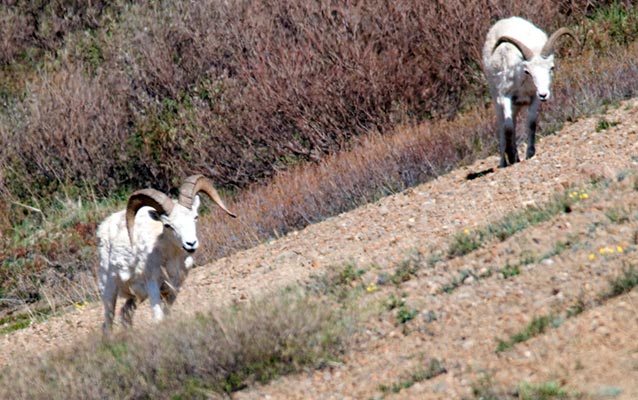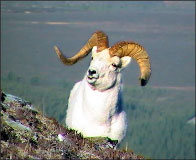Learn about the two ways humans harvest sheep - for subsistence use and in sport hunting.
Hunting and Subsistence

NPS Photo / Kent Miller
Dall sheep are an important game species for subsistence and sport hunters. During times when caribou or moose are not obtainable, Alaska Natives and other rural residents hunt Dall sheep for part of their winter supply of meat. Sport hunters prize sheep for the dramatic horns of the rams, the high-quality meat, and the challenge associated with hunting in extreme alpine environments.
In Depth

Subsistence Hunting
The Inupiat people have a long history of hunting Dall sheep that dates back to at least the 16th century. Sheep are valued for their skin, which is used for warm clothing, and their meat, especially in times when caribou are not available. Historically, the sheep were hunted in summer by foot and in winter by dog sled teams. Today, the rugged terrain in which they live still requires foot travel to reach these animals. The dependence on Dall sheep for meat and clothing fluctuates with caribou populations. Caribou herds declined considerably in the 1940s, and Dall sheep became an important harvest species. Since the 1990s, caribou populations have been large enough to sustain people. Consequently, subsistence harvest of Dall sheep is lower now than in the 1940s, but sheep continue to be an important meat source when caribou migration routes shift during the winter or between years.
Aging Rams for Sport Hunting
Where sport hunting is allowed in Alaska’s national preserves, hunters can harvest mature Dall sheep rams that have horns that are full-curl or greater, have both tips broken off or are eight years of age or older. Horn growth is greatest during the summer and minimal during the winter. This cycle of annual growth produces annuli, which are the dark thin rings laid down during the winter months interspersed with the lighter colored bands of accelerated horn growth in the summer. The age of a ram can be determined by counting the annuli on his horns. For rams greater than eight years of age, there is greater wear at the horn tips than grows from the base each year, and breakage during ram-to-ram clashes or other damage may result in horns with broken or splintered tips.
Sources
- Georgette, S., and H. Loon 1991. Subsistence hunting of Dall’s sheep in northwest Alaska. Technical paper number 208. Division of Subsistence, Alaska Department of Fish and Game. Juneau, Alaska.
Part of a series of articles titled Dall Sheep in Alaska's National Parks.
Previous: The Social Structure of Dall Sheep
Next: Monitoring Dall Sheep
Last updated: November 3, 2022
